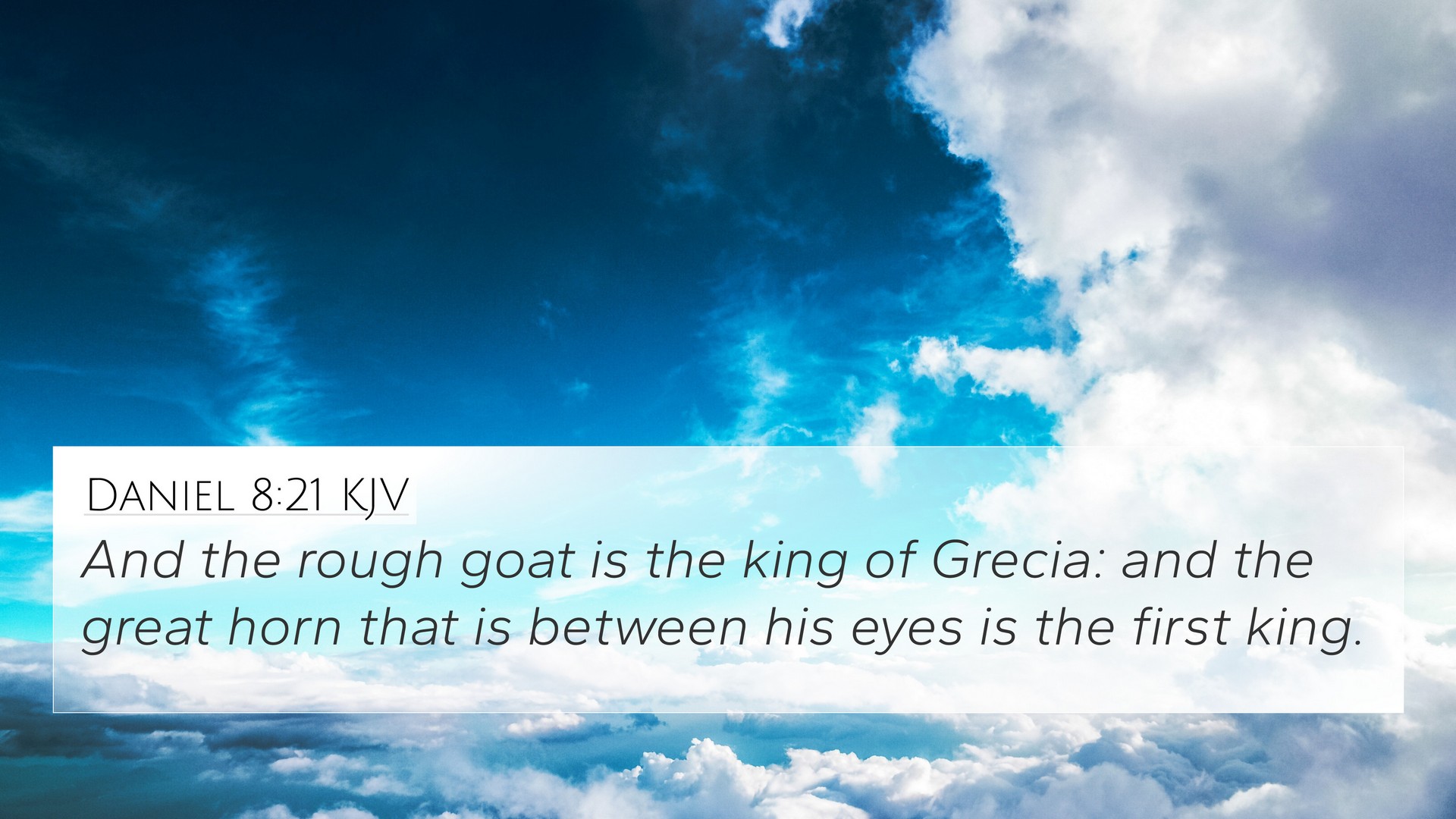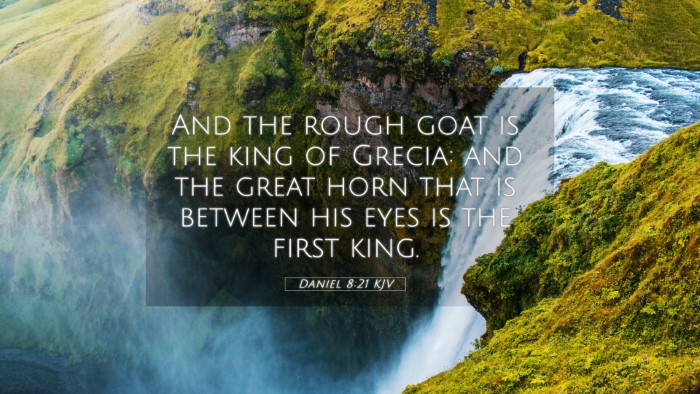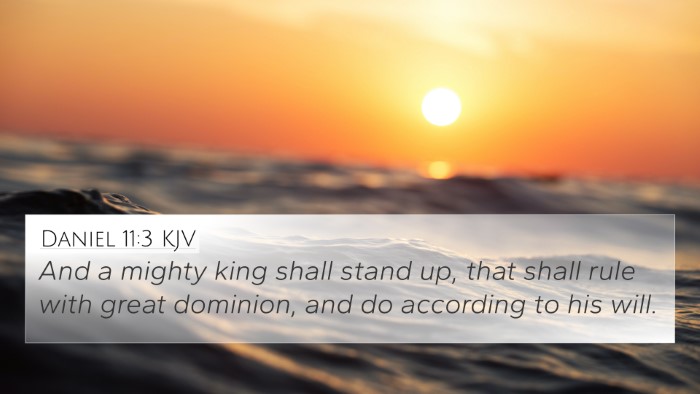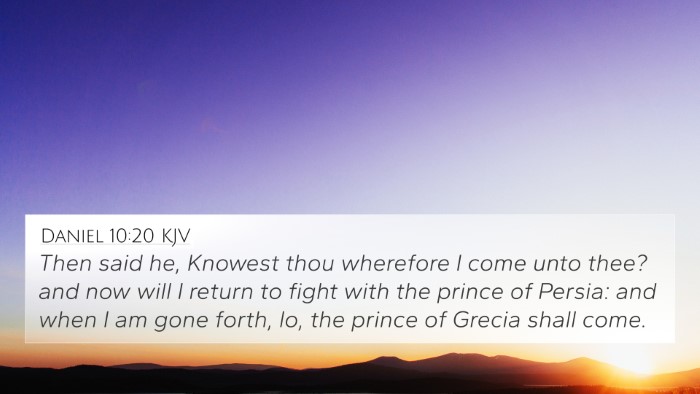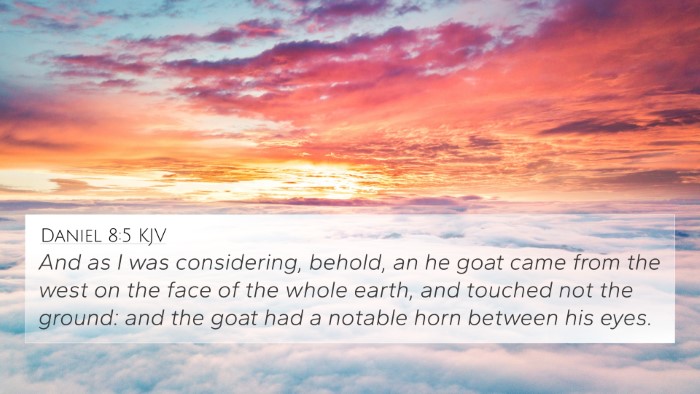Understanding Daniel 8:21: A Comprehensive Bible Verse Analysis
Verse: Daniel 8:21 - "And the rough goat is the king of Grecia: and the great horn that is between his eyes is the first king."
The interpretation of Daniel 8:21 provides a glimpse into the prophetic vision experienced by Daniel, where a symbolic representation of the king of Greece is discussed. This verse represents significant themes in the realm of biblical prophecy and historical fulfillment.
Historical Context
In exploring Daniel 8:21, several public domain commentaries illuminate its context:
- Matthew Henry: He explains that this verse predicts the rise of the Grecian Empire, symbolized by a goat, emphasizing the disparity of power when contrasted with the preceding empires. The 'first horn' signifies Alexander the Great, whose conquests were swift and decisive.
- Albert Barnes: Barnes underscores the importance of recognizing the allegorical nature of this vision, noting that the goat represents Greece and its powerful ruler - the first king, Alexander. This portrayal indicates not only historical accuracy but also the divine sovereignty in guiding the events of empires.
- Adam Clarke: Clarke elaborates on the implications of the goat imagery and its rapid movements, paralleling the swiftness of Alexander’s military campaigns. He articulates that this serves as a testament to God's foresight and the revelation of forthcoming kingdoms to Daniel.
Thematic Connections
This verse opens up a broader dialogue within the scriptural context. It raises important themes pertinent to understanding the biblical narrative and its prophetic messages:
- Prophecy and Fulfillment: Daniel 8:21 emphasizes the certainty of prophecy and its eventual fulfillment. The rise of Greece and its leaders can be cross-referenced with historical accounts in texts like Zechariah 9:13 and Acts 16:9-10, which also mention Greece in significant ways.
- Divine Sovereignty: The passage highlights God's hand in directing the course of history, a theme echoed throughout the Bible, particularly in Isaiah 46:10 and Psalms 22:28 where His control over kingdoms is also affirmed.
- Contrast Between Empires: The transitions from one empire to another create a framework for understanding God’s plan, similar to Daniel 2:39, which discusses the succession of empires as part of divine prophecy.
Cross-References
To deepen the study of Daniel 8:21, several interconnected scriptures enhance the understanding of the themes presented:
- Daniel 2:39 - Discusses the rise and fall of empires in the context of Nebuchadnezzar's dream.
- Daniel 7:6 - Offers a vision of a leopard with four wings, symbolizing rapid conquests similar to that of Greece.
- Daniel 11:3 - Prophecies about the mighty king who will rule as a reflection of Alexander's legacy.
- Ecclesiastes 1:9 - States that there is nothing new under the sun, paralleling the cycles of human history.
- Matthew 24:14 - The Gospel being preached in all nations relates to the eventuality of the Greek influence through Hellenization.
- 2 Timothy 4:18 - Discusses deliverance from every evil work, resonating with God's continued protection through historical shifts.
- Revelation 13:2 - Features a beast empowered by the dragon, linking back to the authority shared by ancient rulers.
Insights into Inter-Biblical Dialogue
The exploration of Daniel 8:21 does not only help in understanding the text itself but also serves as a bridge to other scriptures through the thematic bible verse connections it creates. As readers engage in Bible cross-referencing, insights can be drawn from both the Old Testament prophecies and their New Testament fulfillments.
Application of Cross-Referencing Techniques
This analysis encourages one to utilize tools for bible cross-referencing, such as concordances and guides, enhancing the overall Bible study experience. By understanding how to find cross-references in the Bible, believers can uncover deeper meanings related to the prophetic literature of Daniel and its implications throughout scripture.
Conclusion
Daniel 8:21 serves as a pivotal verse in understanding the prophecy concerning the Grecian Empire and its significant ruler. With the allegorical interpretations provided by various commentaries, readers are encouraged to engage in a comparative bible verse analysis, drawing connections and parallels that enrich their understanding of the Bible as a cohesive narrative.
As one delves deeper into scriptural cross-referencing, new avenues of understanding will emerge, revealing the interconnectedness of God’s redemptive plan through history.
